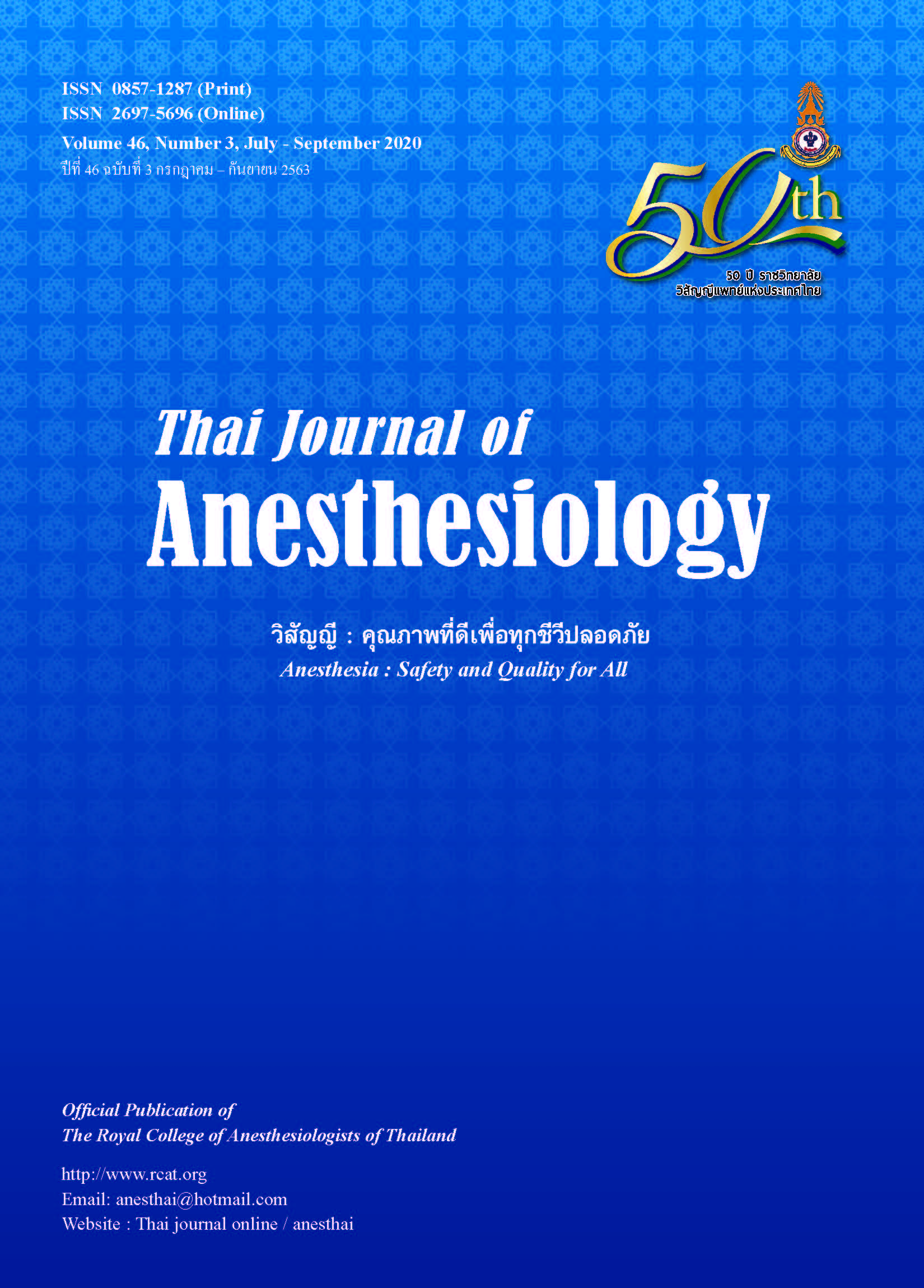Effect of Addition of Ondansetron for PONV Prophylaxis in Ambulatory Hysteroscopy with Propofol Total Intravenous Anesthesia
Main Article Content
Abstract
Background: In female patients undergoing hysteroscopy
in outpatient unit, total intravenous anesthesia (TIVA)
technique with propofol is frequently used as induction and
maintenance drug. Ondansetron is often given as an
antiemetic drug even if propofol infusion has proven to
have antiemetic effect. We hypothesized that the addition
of ondansetron prophylaxis does not alter incident of
postoperative nausea and vomiting (PONV) and post
discharge nausea and vomiting (PDNV) in patients
undergoing hysteroscopy with propofol TIVA technique in
the ambulatory setting.
Method: One hundred and ten female adult patients
scheduled for hysteroscopy in an ambulatory setting were
randomized into a control group (C group) who did not
received any antiemetic drug other than propofol infusion
and an ondansetron group (O group) who received
4 milligrams of ondansetron after induction. Patients’
baseline characteristics, including Apfel’s score, duration
of anesthetic and surgical procedure, and dose of any
drug given were recorded. The incidence of PONV was
recorded in PACU and 2-day incidence of PDNV was
gathered by telephone interview within 2 weeks.
Results: There were no incidences of PONV reported in
PACU in both groups (P>0.99). The overall incidences of
PDNV were lower in the control group, but not statistically
significant (14% vs 5.9%; P=0.2). Daily incidences of
PDNV had no statistic differences. Pain scores, inpatient
admissions, and other complication incidences had no
significant differences.
Conclusion: Addition of ondansetron prophylaxis does not
alter incident of PONV and PDNV in patients undergoing
hysteroscopy with propofol TIVA technique in the
ambulatory setting.
Article Details
References
propofol to prevent postoperative nausea and vomiting.
Anesthesiology 1996;85:1036-42.
2.Odom-Forren J, Jalota L, Moser DK, et al. Incidence and
predictors of postdischarge nausea and vomiting in a 7-day
population. J Clin Anesth 2013;25:551-9.
3. Ong EL, Chiu JL, Chong JL, Kwan KM. Volatile induction and
maintenance (VIMA) versus total intravenous anesthesia
(TIVA) for minor gynecological procedures. Ambu Surgery
2000;8:37-40.
4. Apfel CC, Laara E, Koivuranta M, Greim CA, Roewer N. A
simplified risk scores for predicting postoperative nausea
and vomiting: conclusions from cross-validations between
two centers. Anesthesiology 1999;91:693-700.
5. Figueredo ED, Canosa LG. Ondansetron in the prophylaxis
of postoperative vomiting: a meta-analysis. J Clin Anesth
1998;10:211-21.
6. Gan TJ, Diemunsch P, Habib AS, et al. Consensus guidelines
for the management of postoperative nausea and vomiting.
Anesth Analg 2014;118:85-113.
7. Apfel CC, Philip BK, Cakmakaya OS, et al. Who is at risk for
postdischarge nausea and vomiting after ambulatory
surgery? Anesthesiology 2012;117:475-86.
8. Carlisle JB, Stevenson CA. Drugs for preventing
postoperative nausea and vomiting. Cochrane Database
Syst Rev. Updated 2017;7:CD004125.
9. Apfel CC, Korttila K, Abdalla M, et al. A factorial trial of six
interventions for the prevention of postoperative nausea and
vomiting. N Engl J Med 2004;350:2441-51.
10. Habib AS, White WD, Eubanks S, Pappas TN, Gan TJ. A
randomized comparison of a multimodal management
strategy versus combination antiemetics for the prevention
of postoperative nausea and vomiting. Anesth Analg
2004;99:77-81
11. Alghanem SM, Massad IM, Rashed EM, Abu-Ali HM,
Daradkeh SS. Optimization of anesthesia antiemetic
measures versus combination therapy using dexamethasone
or ondansetron for the prevention of postoperative nausea
and vomiting. Surg Endosc 2010;24:353-8.


